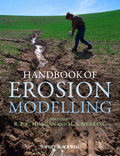
The movement of sediment and associated pollutants over the landscape and into water bodies is of increasing concern with respect to pollution control, prevention of muddy floods and environmental protection. In addition, the loss of soil on site has implications for declining agricultural productivity, lossof biodiversity and decreased amenity and landscape value. The fate of sediment and the conservation of soil are important issues for land managers and decision-makers. In developing appropriate policies and solutions, managers and researchers are making greater use of erosion models to characterise the processes of erosion and their interaction with the landscape INDICE: "CONTENTS.PART ONE: MODEL DEVELOPMENT.1. Introduction.Background to importance of erosion modelling. Problems facing model users. Purpose of theHandbook..2. Model development.Stages in the development of a model from concept to structure and selection of operating functions..3. Model calibration and validation.Reasons for calibration. Data requirements. Validation methods and procedures,.4. Dealing with uncertainty.Reasons for uncertainty in model output. Expected levels of accuracy. Methods for reducing uncertainty..5. Scalingissues.Field, hillslope and catchment scales; problems of upscaling; interconnectivity between slope and river systems..6. Misapplications and misconceptions of models.Problems arising from model misunderstanding and wrong applications. The Universal Soil Loss Equation as a case study..7. Theoretical issues ofmodelling physical systems in erosion models.Problems of expressing physical systems in mathematical terms over time and space...PART TWO: MODEL APPLICATIONS.8. Universal Soil Loss Equation / Revised Universal Soil Loss Equation.Application to an agricultural situation and soil conservation design in the United States..9. Universal Soil Loss Equation.Application to construction sites..10. WEPP.Application to an agricultural problem in the United States..11. WEPP.Application to a problem in South America..12. RHEM.Application of the Rangeland Hydrology and Erosion Model to arid and semi-arid rangeland..13. EUROSEM.Application to an agricultural or environment problem in England..14. EUROSEM.Application to an agricultural catchment in Kenya..15. GUESS.Application to a management problem in southeast Asia..16. LISEM.Application to a catchment in China..17. MORGAN-MORGAN-FINNEY Model.Application to use of buffers for pollution control on farm in England..18. MEDRUSH Suite.Application to catchment in the Mediterranean environment..19. SHE.Application to catchment in either Europeor southeast Asia..20. Erosion modelling within agricultural environments.Application of a Russian erosion model to a problem in Russia..21. RHINEFLOW.Application to large catchments River Rhine case study..22. Modelling erosion within changing climates.Case studies of the new generation of erosion models as applied to climatic change in North America and Europe..23. Erosion modelling within geospatial frameworks.Application of an erosion model to a problem requiring geospatial data and geospatial analysis..24. Web-based applications of erosion models.Development of interactive, web-based tools for erosion assessment, and linkages to on-line databases.25. Risk-based erosion assessment.Application to forest watershed management and planning..26. Risk-based erosion assessment.Application to potential erosion along pipeline rights-of-way in GeorgiaSSR..27. Long-term erosion and landscape models.Application to geomorphological research...PART THREE: FUTURE DEVELOPMENTS.29. Future of erosion modelling.Challenges for model development. Requirements for future models."
- ISBN: 978-1-4051-9010-7
- Editorial: Wiley-Blackwell
- Encuadernacion: Cartoné
- Páginas: 608
- Fecha Publicación: 17/12/2010
- Nº Volúmenes: 1
- Idioma: Inglés
